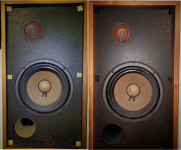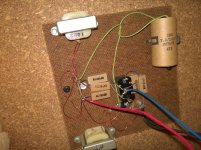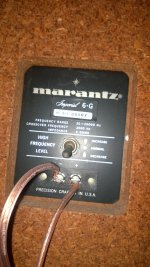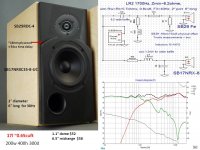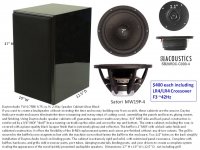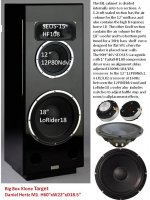Hi there, I am new here and I am looking to get a bit into the DIY audio scene.
To start off I want to refurbish a set of Marantz Imperial 6Gs. I am looking to preserve their inherent qualities, as opposed to trying to make them into a set of speakers they aren't. These won't be the only speakers I tend to own. Right now from what my untrained ears have to tell me, they sound just fine. I have little experience with electronics but I have no problem doing research to learn. What I find difficult is determining what quality speakers to replace the stock ones with, and how important a less or more expensive capacitor and inductors will be.
One of the woofers dome is punctured and both tweeters are dented. I am assuming this can't be repaired and that I'll need to buy a new speakers?
I have uploaded pictures of the speakers as well as schematics.
Here is the list of supplies I'll need to refurbish the speakers. I read here..
http://www.diyaudio.com/forums/multi-way/78350-recapped-imperial-7s-tonight.html
that it would be a good idea to increase the power dissipation in the resistors. So I choose 10w resistors. Though I couldn't find some resistors (at Parts Express) with a 10w buffer. So I listed options for those slots.
If I go to a site like Madi Sound Speaker Store, I can find all of the appropriate resistors and capacitors. Will the Dayton Audio PMPC-6.8 6.8uF be a fine choice for these speakers, or is there any added benifit to geting a more expensive capacitor such as Mundorf 6.8 mfd Supreme Caps. Since I am just starting out, I don't need to jump to extreme Hi-Fi. Probably worth the journey to the top.
All of these parts adds up to ~$230.
Any suggestions for different paths to take? Any guidance would be greatly appreciated.
Cheers,
Daniel
R1
4 ohm 10w resistor
R2
3 ohm 10w resistor
3 ohm 10w resistor
R3
1 ohm 10w resistor
R4
6.2 ohm 5w resistor
R5
8 ohm 5w resistor
OR
8 ohm 20w resistor
OR
8.2 ohm 10w resistor
C1
Dayton Audio PMPC-6.8 6.8uF 250V Precision Audio Capacitor
L1 - 15awg vs 20awg?
Jantzen Audio 1.0mH 15 AWG Air Core Inductor Crossover Coil
L2 - 15awg vs 20awg?
Jantzen Audio 0.60mH 15 AWG Air Core Inductor Crossover Coil
Speaker Replacements
Tweeter Replacement
Woofer Replacement
Future Amplifier Options
I have been considering building the AMP CAMP AMP KIT. Will that kit be able to drive these speakers? Right now these are being used in a small room, and will probably stay there for the foreseeable future. I don't plan on maxing out the volume of the speakers.
To start off I want to refurbish a set of Marantz Imperial 6Gs. I am looking to preserve their inherent qualities, as opposed to trying to make them into a set of speakers they aren't. These won't be the only speakers I tend to own. Right now from what my untrained ears have to tell me, they sound just fine. I have little experience with electronics but I have no problem doing research to learn. What I find difficult is determining what quality speakers to replace the stock ones with, and how important a less or more expensive capacitor and inductors will be.
One of the woofers dome is punctured and both tweeters are dented. I am assuming this can't be repaired and that I'll need to buy a new speakers?
I have uploaded pictures of the speakers as well as schematics.
Here is the list of supplies I'll need to refurbish the speakers. I read here..
http://www.diyaudio.com/forums/multi-way/78350-recapped-imperial-7s-tonight.html
that it would be a good idea to increase the power dissipation in the resistors. So I choose 10w resistors. Though I couldn't find some resistors (at Parts Express) with a 10w buffer. So I listed options for those slots.
If I go to a site like Madi Sound Speaker Store, I can find all of the appropriate resistors and capacitors. Will the Dayton Audio PMPC-6.8 6.8uF be a fine choice for these speakers, or is there any added benifit to geting a more expensive capacitor such as Mundorf 6.8 mfd Supreme Caps. Since I am just starting out, I don't need to jump to extreme Hi-Fi. Probably worth the journey to the top.
All of these parts adds up to ~$230.
Any suggestions for different paths to take? Any guidance would be greatly appreciated.
Cheers,
Daniel
R1
4 ohm 10w resistor
R2
3 ohm 10w resistor
3 ohm 10w resistor
R3
1 ohm 10w resistor
R4
6.2 ohm 5w resistor
R5
8 ohm 5w resistor
OR
8 ohm 20w resistor
OR
8.2 ohm 10w resistor
C1
Dayton Audio PMPC-6.8 6.8uF 250V Precision Audio Capacitor
L1 - 15awg vs 20awg?
Jantzen Audio 1.0mH 15 AWG Air Core Inductor Crossover Coil
L2 - 15awg vs 20awg?
Jantzen Audio 0.60mH 15 AWG Air Core Inductor Crossover Coil
Speaker Replacements
Tweeter Replacement
Woofer Replacement
Future Amplifier Options
I have been considering building the AMP CAMP AMP KIT. Will that kit be able to drive these speakers? Right now these are being used in a small room, and will probably stay there for the foreseeable future. I don't plan on maxing out the volume of the speakers.
Attachments
Last edited:
Just change the cap, that'll make the most audible difference.
Changing the Inductors to a larger gauge of wire may improve efficiency if they're in series with the driver, so you may have to tweak resistor values.
A cheap way to deal with resistors is to parallel 4 lower wattage resistors of 4x the value required
& ideally, if you change drivers, a new crossover is needed with values calculated to suit the replacement drivers
Changing the Inductors to a larger gauge of wire may improve efficiency if they're in series with the driver, so you may have to tweak resistor values.
A cheap way to deal with resistors is to parallel 4 lower wattage resistors of 4x the value required
& ideally, if you change drivers, a new crossover is needed with values calculated to suit the replacement drivers
Unless the woofers are toast, I 'd be inclined to leave them as is - unless you want to play Russian roulette with the change in performance that changing them would deliver.
The phenolic "fried egg" tweeters selected would most likely sound identical to the originals - I doubt that driver design has changed much in over 40yrs.
For upgrading XO components, if they're anything like these, I'd be inclined to leave them as is for now.

You could throw a lot of money at trying to make a silk purse from these, and believe it or don't, while the enclosures could certainly be improved with additional bracing - I like to go between all pairs of opposing panels - the crossovers on many speakers of this vintage were actually decent enough.

I'd replace the screw terminals with binding posts - it looks like they'd be easy enough to get to, and definitely spend the money on the ACA kit - although I couldn't readily find spec on the Imp 6's sensitivity, so the little amp's pwer might not be enough for some folks / large rooms, etc.
The phenolic "fried egg" tweeters selected would most likely sound identical to the originals - I doubt that driver design has changed much in over 40yrs.
For upgrading XO components, if they're anything like these, I'd be inclined to leave them as is for now.

You could throw a lot of money at trying to make a silk purse from these, and believe it or don't, while the enclosures could certainly be improved with additional bracing - I like to go between all pairs of opposing panels - the crossovers on many speakers of this vintage were actually decent enough.

I'd replace the screw terminals with binding posts - it looks like they'd be easy enough to get to, and definitely spend the money on the ACA kit - although I couldn't readily find spec on the Imp 6's sensitivity, so the little amp's pwer might not be enough for some folks / large rooms, etc.
Last edited:
Here is a picture of the crossover in one of the speakers. The other is in a similar condition. They do look pretty good. I will make a point to test each component to see if they are still performing their tasks. When I flip the high frequency level switch, I really don't notice a difference in sound. So I guess that is what inspired me to replace things.
So for now I will possibly change out the capacitor and test some connections. Are the woofers repairable if the drivers are still good?
I may have an opportunity to get a Yamaha M85 & C85 that will need some repair work to get going. So that could get me into the Class A amplifier game.
So for now I will possibly change out the capacitor and test some connections. Are the woofers repairable if the drivers are still good?
I may have an opportunity to get a Yamaha M85 & C85 that will need some repair work to get going. So that could get me into the Class A amplifier game.
Attachments
The IMB cap is no slouch. It's not a cheap NP electrolytic, but a legit film cap of some sort. IMB always did film capacitors to my knowledge, so it's a good question as to whether the cap is paper dielectric or something like polyester or polypropylene film. I have IMB data floating around the house somewhere, but unfortunately from a period of 10-15 years after this particular cap was constructed. The date code might indicate '73, which is definitely from the time period these speakers were made.
I made the rounds with a school colleague back during the early 70's to listen to speakers at the stereo shop. Our favorites were the Fairfax speakers and the Marantz Imperial 7s. They had a nice unstrained quality to the sound, unlike the classic 8" acoustic suspension 2-ways that sounded like they were trying to kick their way out of the box. The Fairfaxes won on points, but they were outside my friend's price range. He ended up buying the Marantz speakers.
I made the rounds with a school colleague back during the early 70's to listen to speakers at the stereo shop. Our favorites were the Fairfax speakers and the Marantz Imperial 7s. They had a nice unstrained quality to the sound, unlike the classic 8" acoustic suspension 2-ways that sounded like they were trying to kick their way out of the box. The Fairfaxes won on points, but they were outside my friend's price range. He ended up buying the Marantz speakers.
Last edited:
So reading between the lines, I'd be inclined to suggest that if you're not worried about keeping these "stock", to finding a setting on the high frequency level switch that you can live with, excise the redundant resistors, upgrade the remaining Rs with maybe even a Dale or equivalent aluminum finned 15W, replace the screw terminals, and definitely add some bracing.
Who knows, these could surprise you.
In any event, don't overlook the ACA kits - even if they lack sufficient balls for these speakers, they are just too delicious to not add to your collection.
Who knows, these could surprise you.
In any event, don't overlook the ACA kits - even if they lack sufficient balls for these speakers, they are just too delicious to not add to your collection.
For fun, try Clarity ESA (on sale) or Mundorf MKP (inexpensive) as your tweeter cap.
Also consider replacing any resistors in series with the tweeter with Mills.
Best,
Erik
Also consider replacing any resistors in series with the tweeter with Mills.
Best,
Erik
So reading between the lines, I'd be inclined to suggest that if you're not worried about keeping these "stock", to finding a setting on the high frequency level switch that you can live with, excise the redundant resistors, upgrade the remaining Rs with maybe even a Dale or equivalent aluminum finned 15W, replace the screw terminals, and definitely add some bracing.
What I may start out with then, is just build a new separate crossover unit, and keep the original intact, and begin trying out different capacitors with that.
What do you mean by add some bracing? Is there anywhere I can read up on this? I am ignorant of what benefit that would add.
Also, which resistors would be redundant and why? Are you suggesting to just focus on the high frequency mode and not worry about rebuilding the other mid and lower frequency options? And are you referring to these type of resistors?
Thanks for your response!
Those sand-damped, wax-filled caps film caps with hand-soldered teflon leads are hard to better.
The IMB cap is no slouch. It's not a cheap NP electrolytic, but a legit film cap of some sort. IMB always did film capacitors to my knowledge, so it's a good question as to whether the cap is paper dielectric or something like polyester or polypropylene film. I have IMB data floating around the house somewhere, but unfortunately from a period of 10-15 years after this particular cap was constructed. The date code might indicate '73, which is definitely from the time period these speakers were made.
I will definitely keep the capacitor and the original setup. I think I will use these speakers to experiment with capacitors and resistors. I think my father purchased these at some point in the 70's. What is funny though is one speaker is a Marantz Imperial 6 and the other is an Imperial 6G. Everything about them is identical.
I will definitely keep the capacitor and the original setup. I think I will use these speakers to experiment with capacitors and resistors. I think my father purchased these at some point in the 70's. What is funny though is one speaker is a Marantz Imperial 6 and the other is an Imperial 6G. Everything about them is identical.
You know, if you want a more modern bit of kit, and want to learn about crossovers my LM-1 is available for free, along with all the simulation files.
There's also a thread on the A26 kit and simulation going too.
Best,
Erik
IT'S ALL ABOUT THE SOUND!!
"Right now from what my untrained ears have to tell me, they sound just fine."
So, keep these as a 'historic reference'. You will never get great sound from a Phenolic Ring Tweeter. Don't waste home audio time with bad sound.
I think your best investments in time and money and brain-cells would be to DIY a proven set of 3-way speakers.
--Draw the shape of your room including speaker plus listener positions.
--Set a budget (you already have $230 in the bank)
--Do you have access to a woodshop, and good building skills?
NOW you have to wander the speaker jungle until you find your Religion.
-basic or exotic drivers?
-HT tall and narrow?
-Econowave horn 93db/watt efficiency?
"I may have an opportunity to get a Yamaha M85 & C85 that will need some repair work to get going."
--let's skip dipole speakers because they require complex equalization and multiple amps.
--let's stay with passive crossovers, and a speaker impedance >5ohms
"Right now from what my untrained ears have to tell me, they sound just fine."
So, keep these as a 'historic reference'. You will never get great sound from a Phenolic Ring Tweeter. Don't waste home audio time with bad sound.
I think your best investments in time and money and brain-cells would be to DIY a proven set of 3-way speakers.
--Draw the shape of your room including speaker plus listener positions.
--Set a budget (you already have $230 in the bank)
--Do you have access to a woodshop, and good building skills?
NOW you have to wander the speaker jungle until you find your Religion.
-basic or exotic drivers?
-HT tall and narrow?
-Econowave horn 93db/watt efficiency?
"I may have an opportunity to get a Yamaha M85 & C85 that will need some repair work to get going."
--let's skip dipole speakers because they require complex equalization and multiple amps.
--let's stay with passive crossovers, and a speaker impedance >5ohms
The character of these speakers comes not from the box, but from the parts. Those woofers are very nice, probably CTS. The tweeters are CTS phenolic ring jobs(not 'fried egg').
You can replace just the dust caps if you must, but it's not an issue in most cases. The tweeters can probably be replaced, dynavox.com has three variants, so one is probably close in parameters and behavior.
The capacitors should be measured for a match. If they match leave them for now, you can swap one at a time for comparisons later.
The coils should not saturate until you are over 100db or so, so they too can wait for now.
Redundancy of resistors is simply a way to get the value or power handling where you need it with available values.
That switch could use a cleaning, as could slip-on conectors if used at drivers.
So-clean, measure, compare, and if you must replace, please send me the parts.
It will take some study to understand both how to test and what it tells you, so be patient and ask questions when you find the inevitable apparent contradictions.
years ago, a customer brought his speakers to Bud Fried with their tweeters pushed in. Bud put them next to each other, pushed one till it matched the other, and said, "this is the free repair, play them with the grills on for the prissy people, to replace the tweeters will be $200".
"if it sounds good, it is good" Duke Ellington
Have fun learning and enjoy.
David
You can replace just the dust caps if you must, but it's not an issue in most cases. The tweeters can probably be replaced, dynavox.com has three variants, so one is probably close in parameters and behavior.
The capacitors should be measured for a match. If they match leave them for now, you can swap one at a time for comparisons later.
The coils should not saturate until you are over 100db or so, so they too can wait for now.
Redundancy of resistors is simply a way to get the value or power handling where you need it with available values.
That switch could use a cleaning, as could slip-on conectors if used at drivers.
So-clean, measure, compare, and if you must replace, please send me the parts.
It will take some study to understand both how to test and what it tells you, so be patient and ask questions when you find the inevitable apparent contradictions.
years ago, a customer brought his speakers to Bud Fried with their tweeters pushed in. Bud put them next to each other, pushed one till it matched the other, and said, "this is the free repair, play them with the grills on for the prissy people, to replace the tweeters will be $200".
"if it sounds good, it is good" Duke Ellington
Have fun learning and enjoy.
David
IT'S ALL ABOUT THE SOUND!!
"Right now from what my untrained ears have to tell me, they sound just fine."
So, keep these as a 'historic reference'. You will never get great sound from a Phenolic Ring Tweeter. Don't waste home audio time with bad sound.
I think your best investments in time and money and brain-cells would be to DIY a proven set of 3-way speakers.
--Draw the shape of your room including speaker plus listener positions.
--Set a budget (you already have $230 in the bank)
--Do you have access to a woodshop, and good building skills?
NOW you have to wander the speaker jungle until you find your Religion.
-basic or exotic drivers?
-HT tall and narrow?
-Econowave horn 93db/watt efficiency?
"I may have an opportunity to get a Yamaha M85 & C85 that will need some repair work to get going."
--let's skip dipole speakers because they require complex equalization and multiple amps.
--let's stay with passive crossovers, and a speaker impedance >5ohms
This is the direction I would like to go in. But with what little brain power I have being focused on finishing my graduate degree, I want to hold off on building loudspeakers from scratch. I have no experience with woodworking or access to woodworking tools. I have the space and tools to work with electronics. In about a year I'll be in a position to start building stuff.
Maybe...Build a pair of speakers over the Christmas break with Dad.
Big picture goal: A pair of high quality 3-way speakers in two cabinets, built in two phases:
1) Start with a tweeter-midrange in a finished 0.75 cuft cabinet from Parts Express. This size cabinet allows for both strong <40Hz bass with a bass reflex ported alignment, and plug-the-port-later sealed midrange alignment for superior transients when a woofer cabinet is added as a later date. Just cut/route holes for speakers and port.
-Two price points: $270/speaker ($100 cabinet + $110 speakers + $45 crossover + $15 port+stuffing+terminals);
and $400/speaker using $185 Satori MW19P-4 midbass upgrade + $75 crossover
2) Separate bass cabinet with woofers sized for listening room. 12" fat_bottom, straight side 10" , two 8" woofers.
3) Birthday Present Speakers for DAD!
Big picture goal: A pair of high quality 3-way speakers in two cabinets, built in two phases:
1) Start with a tweeter-midrange in a finished 0.75 cuft cabinet from Parts Express. This size cabinet allows for both strong <40Hz bass with a bass reflex ported alignment, and plug-the-port-later sealed midrange alignment for superior transients when a woofer cabinet is added as a later date. Just cut/route holes for speakers and port.
-Two price points: $270/speaker ($100 cabinet + $110 speakers + $45 crossover + $15 port+stuffing+terminals);
and $400/speaker using $185 Satori MW19P-4 midbass upgrade + $75 crossover
2) Separate bass cabinet with woofers sized for listening room. 12" fat_bottom, straight side 10" , two 8" woofers.
3) Birthday Present Speakers for DAD!
Attachments
What I may start out with then, is just build a new separate crossover unit, and keep the original intact, and begin trying out different capacitors with that.
What do you mean by add some bracing? Is there anywhere I can read up on this? I am ignorant of what benefit that would add.
In the second of the pictures I posted above (captured from a post on modifying the Imp 6 or 7), you can see a narrow stick of particle board connecting the section of baffle above(?) the woofer cutout to the back panel. I happen to belong to the "thoroughly well braced" school of thought, and while these aren't huge boxes, I'd think they'd still benefit from some additional bracing between at least the sides. Of course getting a perfectly accurate measurement inside the box can be a bit of an iterative process.
As I think I said above, without an actual schematic or reverse engineering of the crossover, it's hard to be sure exactly what's going on - Marantz was not the only company to do some "very interesting things" with their multiways during that era (mid 70s) - but my bet is that combinations of those resisters are wired through the toggle switch to adjust the level balance between woofer and tweeter.Also, which resistors would be redundant and why? Are you suggesting to just focus on the high frequency mode and not worry about rebuilding the other mid and lower frequency options?

So, if you can't discern a bit difference between the settings, but there is still HF output (i.e. the tweeters are functioning), then the resistors associated with the other two switch positions - as well as the switch itself - may be out of circuit / redundant. The trick of course is to prove that, and measure the R value of the single setting you find acceptable.
yup - at at least a couple of bucks a piece, not cheap to replace all 10 resistors in the pair, hence the suggestion above.And are you referring to these type of resistors?
No matter what else, I'd definitely replace those $.10 screw terminal with at least something like
Parts Express Gold Plated Banana 5-Way Speaker Wire Binding Post Terminal
Thanks for your response!
No matter what else, I'd definitely replace those $.10 screw terminal with at least something like
Parts Express Gold Plated Banana 5-Way Speaker Wire Binding Post Terminal
I'll do this and look and building a second crossover for fun and look into bracing. In the initial post I provided the crossover schematic for these speakers.
Thanks!
The character of these speakers comes not from the box, but from the parts. Those woofers are very nice, probably CTS. The tweeters are CTS phenolic ring jobs(not 'fried egg').
You can replace just the dust caps if you must, but it's not an issue in most cases. The tweeters can probably be replaced, dynavox.com has three variants, so one is probably close in parameters and behavior.
The capacitors should be measured for a match. If they match leave them for now, you can swap one at a time for comparisons later.
David
Thank you. I was curious if the punctures really altered the sound at all. I definitely would like to keep the characteristics of the speakers. I may play around with the components to get an idea of how things change.
Cheers.
You know that these are never going to be "Great" speakers so before you do anything else try simple things
First would be adding more FG on the back panel, leave the port clear but stuff as much fibreglass as you can into the box and then listen.
If you are worried about fibre migration or irritation put some polyester in front of it
Side to side bracing of the box may be a touch difficult but gluing some MDF off-cuts to the sides is an easy tweak
I've yet to meet a speaker of this era that wasn't markedly improved by simply adding FG and/or polyester fill to the box, sealed or ported
First would be adding more FG on the back panel, leave the port clear but stuff as much fibreglass as you can into the box and then listen.
If you are worried about fibre migration or irritation put some polyester in front of it
Side to side bracing of the box may be a touch difficult but gluing some MDF off-cuts to the sides is an easy tweak
I've yet to meet a speaker of this era that wasn't markedly improved by simply adding FG and/or polyester fill to the box, sealed or ported
Maybe..... during your holiday shopping you can visit a high-end audio dealer and listen to a few $3k-5k 3-way speakers to refresh your memory on good stereo sound/soundstage, similar to what you can diy for $800 - $1000.
"Right now from what my untrained ears have to tell me, they sound just fine."
"Right now from what my untrained ears have to tell me, they sound just fine."
- Home
- Loudspeakers
- Multi-Way
- Refurbishing Marantz Imperial 6 Speakers
